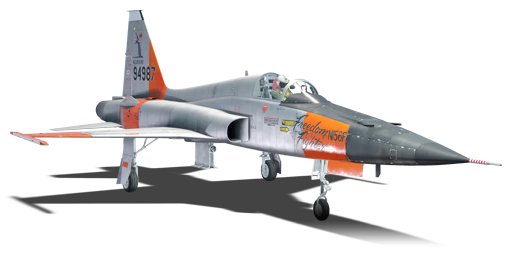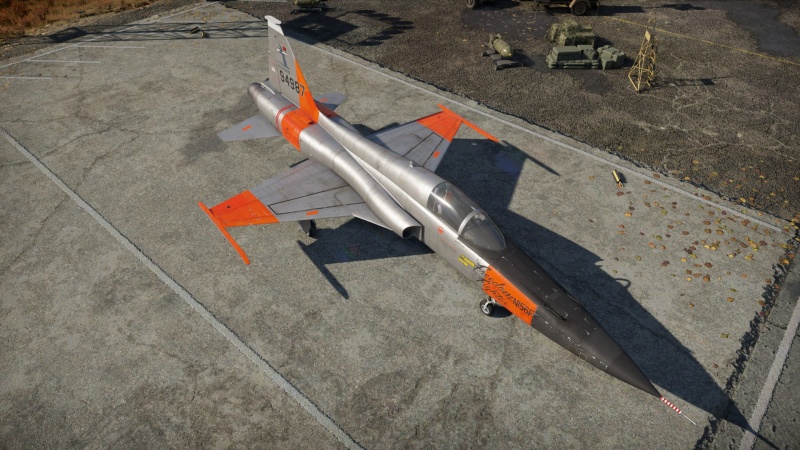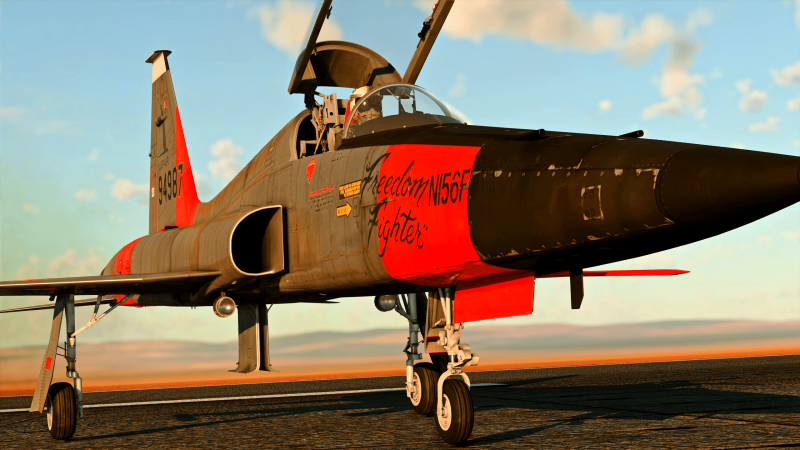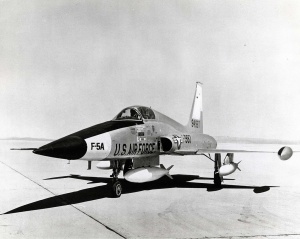F-5A
| This page is about the American jet fighter F-5A. For other versions, see F-5 (Family). |
Contents
Description
The F-5’s roots begin way back in the mid-1950s. After a tour around Europe and Asia, Northrop’s team saw the need for a supersonic fighter that was cheap and easy to maintain. In 1955, the N-156 was formally brought into fruition and work began. It ultimately evolved into the N-156F and although the Navy and Air Force weren’t interested in it, Northrop pursued the idea. Several years later in 1962, the DoD formally announced that the N-156F would be its chosen aircraft for the Military Assistance Program (MAP). This led to the F-5A serving with U.S. forces as a cheap and easy-to-maintain fighter and ultimately being one of the best export-type fighters ever built.
Introduced in Update "Direct Hit" as a reward for the 2021 Export Order event, the F-5A Freedom Fighter is a very strong fighter. It has favorable flight characteristics and excels in dogfighting thanks to its light and small airframe. The F-5A also has 60 countermeasures which are very important at its battle rating for survival. Although the F-5A can only carry two AIM-9Es, the guns are excellent and enemy planes can easily be taken down with a short burst. The F-5A also has an extensive list of bombs and rockets although players should stick to attacking enemy fighters where the F-5A excels at. Nonetheless, players will be satisfied with the F-5A’s overall performance and capability.
General info
Flight performance
The F-5A has very good flight performance. It turns quite well at around 700 km/h (437.5 mph) and is overall a great dogfighter. Although the engines are weak compared to other fighters, the F-5A can still reach a respectable top speed of 1,443 km/h (~902 mph). However, it does take a while to reach that speed so the F-5A isn’t very suited to running down enemy planes or outrunning them. At lower speeds, the F-5A is still quite good but it’s ill-advised to be slow with enemy planes nearby. The F-5A’s acceleration is also less than stellar which is another reason to stay relatively fast unless absolutely necessary.
| Characteristics | Max Speed (km/h at 10,668 m) |
Max altitude (metres) |
Turn time (seconds) |
Rate of climb (metres/second) |
Take-off run (metres) | |||
|---|---|---|---|---|---|---|---|---|
| AB | RB | AB | RB | AB | RB | |||
| Stock | 1,429 | 1,421 | 27.1 | 28.2 | 112.4 | 99.2 | 850 | |
| Upgraded | 1,460 | 1,443 | 26.9 | 27.0 | 159.1 | 133.6 | ||
Details
| Features | |||||
|---|---|---|---|---|---|
| Combat flaps | Take-off flaps | Landing flaps | Air brakes | Arrestor gear | Drogue chute |
| ✓ | ✓ | ✓ | ✓ | X | ✓ |
| Limits | ||||||
|---|---|---|---|---|---|---|
| Wings (km/h) | Gear (km/h) | Flaps (km/h) | Max Static G | |||
| Combat | Take-off | Landing | + | - | ||
| 926 | 560 | 555 | ~11 | ~5 | ||
| Optimal velocities (km/h) | |||
|---|---|---|---|
| Ailerons | Rudder | Elevators | Radiator |
| < 680 | < 750 | < 700 | N/A |
Engine performance
| Engine | Aircraft mass | ||||||
|---|---|---|---|---|---|---|---|
| Engine name | Number | Basic mass | Wing loading (full fuel) | ||||
| General Electric J85-GE-13 | 2 | 4,051 kg | 365 kg/m2 | ||||
| Engine characteristics | Mass with fuel (no weapons load) | Max Takeoff Weight | |||||
| Weight (each) | Type | 11m fuel | 20m fuel | 30m fuel | 37m fuel | ||
| 271 kg | Afterburning axial-flow turbojet | 4,580 kg | 4,992 kg | 5,462 kg | 5,814 kg | 9,000 kg | |
| Maximum engine thrust @ 0 m (RB/SB) | Thrust to weight ratio @ 0 m (WEP) | ||||||
| Condition | 100% | WEP | 11m fuel | 20m fuel | 30m fuel | 37m fuel | MTOW |
| Stationary | 960 kgf | 1,426 kgf | 0.62 | 0.57 | 0.52 | 0.49 | 0.32 |
| Optimal | 1,200 kgf (1,400 km/h) |
2,459 kgf (1,400 km/h) |
1.07 | 0.99 | 0.90 | 0.85 | 0.55 |
Survivability and armour
The F-5A has neither armour plates nor bulletproof glass and the fuel tanks are self-sealing.
Modifications and economy
Armaments
Offensive armament
The F-5A is armed with:
- A choice between two presets:
- 2 x 20 mm M39A2 cannons, nose-mounted (280 rpg = 560 total)
- 2 x 20 mm M39A2 cannons + 60 x countermeasures
Suspended armament
The F-5A can be outfitted with the following ordnance:
| 1 | 2 | 3 | 4 | 5 | 6 | 7 | ||
|---|---|---|---|---|---|---|---|---|
| 250 lb LDGP Mk 81 bombs | 6 | 6 | 6 | |||||
| 500 lb LDGP Mk 82 bombs | 1 | 1 | 1 | 1 | 1 | |||
| 500 lb Mk 82 Snakeye bombs | 1 | 1 | 1 | 1 | 1 | |||
| 750 lb M117 cone 45 bombs | 1 | 1 | 1 | 1 | 1 | |||
| 1,000 lb LDGP Mk 83 bombs | 1 | 1 | 1 | |||||
| 2,000 lb LDGP Mk 84 bombs | 1 | |||||||
| BLU-1 incendiary bombs | 1 | 1 | 1 | 1 | 1 | |||
| FFAR Mighty Mouse rockets | 19 | 19 | 19 | 19 | ||||
| Zuni Mk32 Mod 0 ATAP rockets | 4 | 4 | ||||||
| AGM-12B Bullpup missiles | 1 | 1 | 1 | 1 | ||||
| AIM-9E Sidewinder missiles | 1 | 1 |
| Default weapon presets | |
|---|---|
| |
Usage in battles
As the F-5A does not have any radar-guided missiles (AIM-7s or equivalent), and it's not particularly fast, it is recommended to stay low and try to avoid the first clash between teams by flying to the side. When flying into the aforementioned engagement zone, pick out single fights or distracted enemies. The AIM-9E is not a reliable weapon and is easy to dodge, so try not to take missile shots from the sides or at a heavily manoeuvring opponent. When the opportunity to dogfight arises, take it only when you're sure other enemies are either distanced or far enough away from your position to not interrupt your fight and pick you off. When in a dogfight, you are almost always superior in manoeuvrability when compared to your opponent. MiG-21s or the J35s will be better in the first turn, but they bleed a lot of speed due to their delta wing design. Avoid their guns in the first turn, and use yours to take them out. While you have only 2 guns, they have a high muzzle velocity, making them easy to aim. The only downside with the cannons is their damage potential: you need to put several rounds on a target to destroy it.
Pros and cons
Pros:
- Excellent manoeuvrability
- Great amount of Countermeasures
Cons:
- Relatively low top speed
- No radar-guided missiles
History
The F-5A Freedom Fighter is a light fighter designed by Northrop in the 1950s. Designed as a private export venture, the aircraft was designed in both fighter and trainer variants (N-156F and N-156T). The F-5A entered service in the 1960s and was widely exported under the US's Military Assistance Program to developing countries. The F-5A would later be developed into the more advanced F-5E, and later on, serve as the basis of the YF-17 / F/A-18.
Design and development
Design work for the F-5 began in the early 1950s under the leadership of Northrop's VP of engineering Edgar Schmued, who was well-known for his work in designing the P-51 Mustang and F-86 Sabre with North American Aviation. By 1955, the design team had selected the General Electric J85 engine as the powerplant. That year, the US Navy issued a requirement for a light jet fighter to operate off its escort carriers, and Northrop quickly adapted its prototype design for naval service; however, the Navy requirement disappeared when the escort carriers were retired, and Northrop redesigned its aircraft once again. By this time, the prototypes were designated as the N-156T and N-156F, as trainer and fighter variants, respectively.
The final design of the N-156 would emerge in March of 1956, with a conventional wing design and its two J85 engines mounted in the rear fuselage. While the USAF had little interest in a light fighter such as the N-156F, it selected the N-156T as the replacement of the T-33 Shooting Star, which would go on to enter service as the T-38 Talon. The first YT-38 would fly in July of 1959 and serve as the USAF's primary trainer, a role it continues to serve today. Meanwhile, the USAF also ordered three N-156F prototypes to fulfil its requirement for a low-cost fighter that could be exported to less developed countries under the Military Assistance Program (MAP). This role was confirmed by the Kennedy administration's selection of the N-156F as the winner of the F-X competition, for a low-cost fighter to be exported under the MAP program. The N-156F was subsequently renamed the F-5 "Freedom Fighter".
The F-5A's design centered on its two J85 engines, each producing up to 22 kn of thrust with afterburner. While initial N-156 prototypes had engines mounted mid-wing and ahead of the tail (similar to the F-4), the final design featured a pair of engines at the rear of the vehicle. The F-5 could attain a speed of Mach 1.4 at high altitude and could carry up to 6200 lbs of ordnance on five underwing hardpoints. Being optimized for ground attack, the F-5 lacked an air-to-air radar. However, it could carry two AIM-9 Sidewinders on wingtip pylons along with its nose-mounted 20 mm cannons.
Operational service
Being designed for export, a total of 624 F-5As were produced by Northrop, including 3 YF-5A prototypes. Another 200 F-5B two-seater aircraft were produced, lacking internal cannons but otherwise combat-ready. Additionally, Canadair produced 140 aircraft under license for the Royal Canadian Air Force, while CASA in Spain produced 70 aircraft. The F-5A was widely exported under the MAP program to countries including Iran, South Korea, the Philippines, Turkey, Greece, and the Republic of China, while Norway, Spain and Canada purchased/produced the aircraft directly. With the success of the F-5A, the USAF acquired 12 airframes from the MAP program for combat trials in Vietnam, under the code name "Skoshi Tiger" ("Little Tiger"); this led to the F-5's "Tiger" nickname. The Skoshi Tigers received modifications to instruments and the addition of a fueling probe, and were redesignated F-5C.
Later on, the F-5A would lead to more advanced variants. In 1970, Northrop won a competition for a new light export fighter, with a much larger focus on air-to-air combat to counter the threat from late-generation MiG-21s. This aircraft was the F-5E/F, advanced versions of the earlier F-5A/Bs now renamed "Tiger II". The F-5E was similarly widely-exported and modified versions are still in service with export customers, and several aircraft served with NAS Miramar (the so-called TOPGUN) as adversary aircraft, mimicking the MiG-21. Finally, the F-5A's airframe served as the basis of several design studies which culminated in the YF-17 "Cobra", a light fighter that lost the USAF LightWeight Fighter (LWF) competition to the F-16 Fighting Falcon. The YF-17 would later be enlarged into the F/A-18 Hornet, which is operated by the US Navy as a multirole combat aircraft.
Media
- Skins
See also
Links to the articles on the War Thunder Wiki that you think will be useful for the reader, for example:
- reference to the series of the aircraft;
- links to approximate analogues of other nations and research trees.
External links
References
- Sherman, R. (1999, December 27). F-5 Freedom Fighter / Tiger. FAS Military Analysis Network. Retrieved December 22, 2021, from https://man.fas.org/dod-101/sys/ac/f-5.htm
- Yarrish, G. (2020, February 26). Northrop F-5 Freedom Fighter. Flight Journal. Retrieved December 22, 2021, from https://www.flightjournal.com/northrop-f-5-freedom-fighter/
| USA jet aircraft | |
|---|---|
| Fighters | |
| F9F | F9F-2 · F9F-5 · F9F-8 |
| F-80 | F-80A-5 · F-80C-10 |
| F-84 | F-84B-26 · F-84F · F-84G-21-RE |
| F-86 | F-86A-5 · F-86F-25 · F-86F-2 · F-86F-35 |
| F-89 | F-89B · F-89D |
| F-100 | F-100D |
| F-104 | F-104A · F-104C |
| F-4 | F-4C Phantom II · F-4E Phantom II · F-4J Phantom II · F-4S Phantom II |
| F-5 | F-5A · F-5C · F-5E · F-20A |
| F-8 | F8U-2 · F-8E |
| F-14 | F-14A Early · ▄F-14A IRIAF · F-14B |
| F-15 | F-15A · F-15C MSIP II · F-15E |
| F-16 | F-16A · F-16A ADF · F-16C |
| Other | P-59A · F2H-2 · F3D-1 · F3H-2 · F4D-1 · F11F-1 |
| Strike Aircraft | |
| FJ-4 | FJ-4B · FJ-4B VMF-232 |
| A-4 | A-4B · A-4E Early |
| A-7 | A-7D · A-7E · A-7K |
| AV-8 | AV-8A · AV-8C · AV-8B Plus · AV-8B (NA) |
| A-10 | A-10A · A-10A Late · A-10C |
| F-111 | F-111A · F-111F |
| Other | A-6E TRAM · F-105D · F-117 |
| Bombers | |
| B-57 | B-57A · B-57B |








